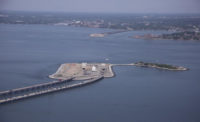National Park Service OKs Potomac River CSO Tunnel
The National Park Service has approved a proposal to construct a 5-mile-long combined sewer overflow tunnel beneath the Potomac River in Washington, D.C.
The project, to be built by DC Water, the District’s water and sewer authority, is part of the ongoing $2.7-billion DC Clean Rivers program, designed to substantially reduce the volume of CSOs flowing into the region’s waterways. DC Water estimates that 654 million gallons of CSOs enter the Potomac River annually in years with average rainfall. The tunnel, along with new diversion facilities, an emergency overflow structure and other supporting infrastructure is expected to reduce that volume by 93%, and all but eliminate the more than 70 overflow events that occur in the District each year.
Plans call for the 18-ft-dia tunnel to be excavated between 100 and 150 ft underground using a tunnel boring machine and lined with concrete segments. Launched from near the mouth of Rock Creek Park in northwest D.C., the tunnel will follow a corridor beneath the river and NPS-administered land, and link with DC Water’s existing Anacostia River Tunnel, which channels CSO flow to the Blue Plains Advanced Wastewater Treatment Plant.
DC Water anticipates beginning industry outreach early next year, with a contractor to be selected in mid-2022. Construction would get underway sometime in 2023.
The Potomac River tunnel is the final major element of the DC Clean Rivers program, which aims to reduce CSO volume from the District’s century-old sewer system by 96% upon full build-out in 2030. Since the first facilities came on line in 2018, the program’s network of tunnels, green infrastructure and anaerobic digester technology at the Blue Plains plant have collected and treated more than 7.4 billion gallons of combined sewage, according to DC Water. Nearly 3,500 tons of trash, debris and other solids have been captured as well.
A joint venture of Salini Impregilo/Lane Construction and S.A. Healy is currently working on the system’s latest addition, a $583-million 23-ft dia tunnel beneath the District’s northeastern neighborhoods to improve water quality in the Anacostia River.
Having covered approximately 60% of the nearly 5-mile route, the project’s tunnel boring machine, “Chris,” is currently undergoing a planned pause for cleaning and maintenance. Excavation of the remaining 11,000 ft is expected to resume in May, with the tunnel scheduled to become operational in 2023.







